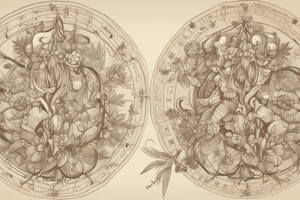Podcast
Questions and Answers
According to the text, which of the following is a function of Yin in Chinese medicine?
According to the text, which of the following is a function of Yin in Chinese medicine?
- Warming
- Provides space for rest (correct)
- Transports
- Creates the spark for conception
According to the text, which of the following is a function of Yang in Chinese medicine?
According to the text, which of the following is a function of Yang in Chinese medicine?
- Nourishing
- Holds
- Moves (correct)
- Cooling
According to the text, which of the following is a characteristic of Yin in Chinese medicine?
According to the text, which of the following is a characteristic of Yin in Chinese medicine?
- Radiant
- Female (correct)
- Hot
- Light
According to the text, which of the following is a characteristic of Yang in Chinese medicine?
According to the text, which of the following is a characteristic of Yang in Chinese medicine?
According to the text, what is the relationship between Yin and Yang?
According to the text, what is the relationship between Yin and Yang?
According to the text, what happens when there is an excess of Yin in the body?
According to the text, what happens when there is an excess of Yin in the body?
According to the text, what happens when there is a decrease in Yang in the body?
According to the text, what happens when there is a decrease in Yang in the body?
According to the text, what happens when there is a decrease in Yin in the body?
According to the text, what happens when there is a decrease in Yin in the body?
According to the text, what is the concept of inter-transformation between Yin and Yang?
According to the text, what is the concept of inter-transformation between Yin and Yang?
According to the text, what is the concept of mutual consumption between Yin and Yang?
According to the text, what is the concept of mutual consumption between Yin and Yang?
Which of the following best describes Traditional Chinese Medicine (TCM)?
Which of the following best describes Traditional Chinese Medicine (TCM)?
What is the historical significance of the Huang Di Nei Jing (The Yellow Emperor's Inner Classic)?
What is the historical significance of the Huang Di Nei Jing (The Yellow Emperor's Inner Classic)?
When did acupuncture and Chinese herbal remedies originate?
When did acupuncture and Chinese herbal remedies originate?
What is the significance of the Five Elements (Wu Xing) in TCM?
What is the significance of the Five Elements (Wu Xing) in TCM?
According to TCM, how is the body viewed?
According to TCM, how is the body viewed?
What is the main focus of naturopathic therapeutics in TCM?
What is the main focus of naturopathic therapeutics in TCM?
What is the relationship between Yin and Yang in TCM?
What is the relationship between Yin and Yang in TCM?
What is the significance of the Book of Changes (Yi Jing) in TCM?
What is the significance of the Book of Changes (Yi Jing) in TCM?
When were the concepts of Yin and Yang firmly established in TCM?
When were the concepts of Yin and Yang firmly established in TCM?
What is the significance of the Channel theory in TCM?
What is the significance of the Channel theory in TCM?
According to TCM principles, what is the best approach to healthcare?
According to TCM principles, what is the best approach to healthcare?
According to TCM, how does the body communicate its health status?
According to TCM, how does the body communicate its health status?
What is the concept of Yin-Yang in Chinese medicine?
What is the concept of Yin-Yang in Chinese medicine?
What does the character '陰 / 阴 (yīn)' represent in Yin-Yang theory?
What does the character '陰 / 阴 (yīn)' represent in Yin-Yang theory?
What does the character '陽 / 阳 (yáng)' represent in Yin-Yang theory?
What does the character '陽 / 阳 (yáng)' represent in Yin-Yang theory?
How does TCM approach the treatment of different disorders?
How does TCM approach the treatment of different disorders?
What are the main methods of treatment in TCM?
What are the main methods of treatment in TCM?
What is the definition of pulse in TCM?
What is the definition of pulse in TCM?
Match the following pulse areas with their element.
Match the following pulse areas with their element.
Match the areas for pulse on the arm
Match the areas for pulse on the arm
Match the position on the LEFT arm to the organ it corresponds with.
Match the position on the LEFT arm to the organ it corresponds with.
Match the location on the RIGHT arm with the organ it corresponds with.
Match the location on the RIGHT arm with the organ it corresponds with.
TCM uses the tongue as a valuable diagnostic tool. It is considered reliable and a reflection of the true condition of the body. Appearance is useful in tracking the state of a condition.
TCM uses the tongue as a valuable diagnostic tool. It is considered reliable and a reflection of the true condition of the body. Appearance is useful in tracking the state of a condition.
Study Notes
Yin and Yang in Chinese Medicine
- Yin represents the receptive, passive, and cool principles, associated with the feminine, darkness, and cold.
- Yang represents the creative, active, and warm principles, associated with the masculine, light, and heat.
- The relationship between Yin and Yang is one of interdependence, interconnectedness, and mutual opposition.
- Yin and Yang are constantly interacting and influencing each other, and their balance is essential for maintaining harmony and health.
Characteristics of Yin and Yang
- Yin is characterized by receptivity, coolness, and passivity, and is associated with functions such as nourishing, moisturizing, and calming.
- Yang is characterized by creativity, activity, and warmth, and is associated with functions such as stimulating, energizing, and moving.
Imbalance and Health
- An excess of Yin in the body can lead to symptoms such as coldness, dampness, and stagnation.
- A decrease in Yang in the body can lead to symptoms such as fatigue, weakness, and coldness.
- A decrease in Yin in the body can lead to symptoms such as heat, dryness, and inflammation.
Traditional Chinese Medicine (TCM)
- TCM is a holistic system of medicine that views the body as an interconnected system, with a focus on treating the individual rather than the disease.
- The historical significance of the Huang Di Nei Jing (The Yellow Emperor's Inner Classic) is that it is the foundational text of TCM, providing a comprehensive understanding of the body and its functions.
- Acupuncture and Chinese herbal remedies originated over 2,000 years ago.
- The Five Elements (Wu Xing) are significant in TCM, as they represent the five fundamental patterns and processes of the natural world, and are used to understand and diagnose patterns of disharmony.
- The body is viewed as a complex system of interconnected channels, or meridians, through which the life-force energy, or Qi, flows.
- The main focus of naturopathic therapeutics in TCM is to restore balance and harmony to the body, rather than simply treating symptoms.
- The relationship between Yin and Yang is one of dynamic interdependence, and is used to understand patterns of disharmony and restore balance.
Diagnosis and Treatment
- The concept of inter-transformation between Yin and Yang refers to the dynamic and cyclical process of change and transformation.
- The concept of mutual consumption between Yin and Yang refers to the way in which one aspect can consume or deplete the other, leading to imbalance.
- The Book of Changes (Yi Jing) is significant in TCM, as it provides a framework for understanding and working with the dynamic patterns of change.
- The Channel theory is significant in TCM, as it provides a framework for understanding the flow of Qi and the diagnosis and treatment of patterns of disharmony.
- The best approach to healthcare in TCM is to prevent disease and maintain balance, rather than simply treating illness.
- The body communicates its health status through the pulse, tongue, and other diagnostic tools.
- The main methods of treatment in TCM include acupuncture, herbal remedies, and other natural therapies.
- The pulse is a diagnostic tool used to assess the flow of Qi and identify patterns of disharmony.
- The tongue is a valuable diagnostic tool, providing information about the body's internal environment and the balance of Yin and Yang.
Studying That Suits You
Use AI to generate personalized quizzes and flashcards to suit your learning preferences.
Related Documents
Description
Test your knowledge on the fundamentals of Traditional Chinese Medicine (TCM) in this introductory quiz. Learn about the historical and cultural context of naturopathic therapeutics, as well as the underlying theories and principles of TCM. This quiz will help you understand and apply TCM theories in clinical practice as a naturopathic physician.




